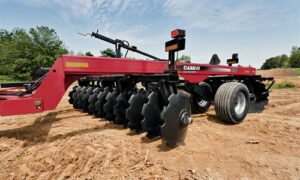Description
Disks used in brush control are heavy-duty with two gangs of disks. Offset disks chop and turn under surface debris and uproot shallow-rooted, sprouting brush species. They consist of two gangs of disks set at angles to each other. Each gang has a separate frame and axle assembly. On some models gang angles can be adjusted for varying soil conditions or desired disking action. Blades may be notched or straight edged and vary from 24 to 36 inches in diameter. Disks range from 8 to 15 feet in width and require tractors with 70 to 350 drawbar horsepower. These disks usually have rubber tires that are raised and lowered hydraulically for transport or depth control. Disks without wheels are hinged and they must be transported on trailers.
Offset disks can also be used for site preparation. They chop and turn under surface debris, breakup shallow compacted layers, till, and uproot small woody plants. Offset disks consist of two gangs of disks set at angles to each other. Each gang has a separate frame and axle assembly. On some models gang angles can be adjusted for varying soil conditions or desired disking action. Blades may be notched or straight edged and vary from 22 to 28 inches in diameter. Some models are designed specifically for rocky soil. Offset disks range from 6 to 22 feet in width and require tractors with 70 to 300 PTO horsepower. These disks have rubber tires that are raised and lowered hydraulically for depth control or transport.
Application
Disks with 36-inch blades are used for brush control on undisturbed soil while units with blade diameters less than 30 inches are used for seedbed preparation following root plowing. In both situations, disks bury much of the surface brush debris and form a desirable seedbed. Most disks used on rangeland employ notched disk blades to chop and bury debris. Disks can be used on a wide range of soil conditions and moderately rocky soil, but they cannot be used if there is excessive timber or rock. Farm-type disks are not suited for the rigors of debris-littered rangeland.
Offset disks are used for primary seedbed preparation where small to medium amounts of debris and vegetation are present. Blade diameters larger than 30 inches are used for brush control on undisturbed soil. Disks are a popular method of tilling soil from a depth of a few inches to 9 inches for revegetation projects. Most disks used on rangeland employ notched disk blades to chop and bury debris. If brush debris is not present, then rubber-tired tractors are used to pull the disks. These disks are marketed as heavy-duty farm units.
Offset disks can be used on a wide range of soil conditions and moderately rocky soil, but they cannot be used if there is excessive woody debris or large rocks and can cause subsurface compaction if used in overly wet conditions.
References / Additional Information
Stevens, R.; Monsen, S.B. 2004. Chapter 9. Mechanical plant control. In: Monsen, S.B.; Stevens, R.; Shaw, N.L., comps. Restoring western ranges and wildlands, vol. 1. Gen. Tech. Rep. RMRS-GTR-136-vol-1. Fort Collins, CO: U.S. Department of Agriculture, Forest Service, Rocky Mountain Research Station: 65-88.
Wiedemann, H.T. 2007. Sculpting brush mechanically: Current state of the art. Rangelands. 29(5): 10-17.


